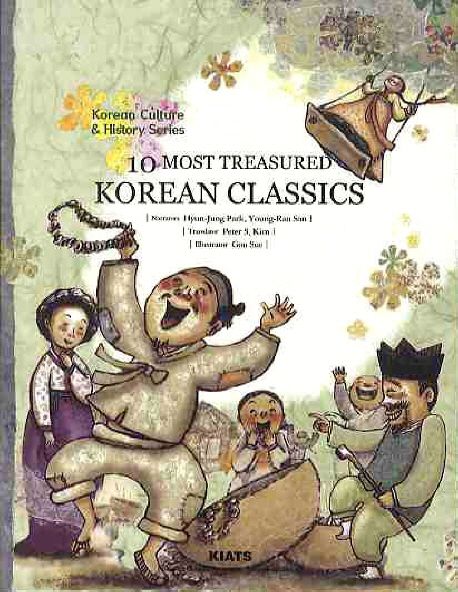

| 상품 안내 및 환불, 교환, 배송문의 | |
| - 가게 전화번호 : | 1544-1900 |
| - 전화문의 시간 : |
오전 9시부터 오후 6시까지 (매주 월요일, 화요일, 수요일, 목요일, 금요일, 공휴일 제외) |
| - 가게 이메일 : | ink@kyobobook.co.kr |
| - 이용 택배회사 : | CJ대한통운 |
|
판매가게정보 |
|
| - 사업자명 : | (주)교보문고 |
| - 사업자등록번호 : | 102-81-11670 |
| - 통신판매업신고 : | 01-0653 |
|
- 현금영수증 : 발급가능 |
|
|
전화주문 및 결제문의 |
|
| - 꽃피는 아침마을 : | 1644-8422 |
|
가게와 직거래를 하시면 꽃송이 적립 및 각종 혜택에서 제외되고, 만일의 문제가 발생하는 경우에도 꽃마의 도움을 받으실 수 없습니다. 가게의 부당한 요구, 불공정 행위 등에 대해서도 꽃마로 직접 전화주세요. |
|

| 상세정보 | 구매후기 (0개) | 상품 Q&A (0) | 배송/교환/환불 안내 |
책소개<춘향전>, <심청전>, <흥부전>, <옹고집전>, <양반전>, <허생전> 등 예부터 전해지는 우리나라 전래 동화 10편을 영어로 소개한다. 한국 고유의 것이 지니는 멋과 맛을 고전작품을 통해 만나볼 수 있다. (영어원서)
상세이미지 저자소개저자 : 박현정
Narrator Hyun-Jung Park is Majored in Korean Education. Worked as a magazine reporter, screen writer, publication specialist, and freelance writer specializing in publication projects. Currently a member of Morning Tree, a literary consortium of professional writers of children’s books and is devoted to producing diverse works in the fields of humanities and education. Wrote for “Now, We Go to the Woods,” a production of MBC TV’s Best Theaters and co-authored other books.
목차The Story of Chun-Hyang
The Story of Sim Cheong
The Story of Heung-Bu
The Story of Ong Go-Jib
The Story of Yangban
The Story of Heo-Saeng
The Story of Hong Gil-Dong
The Story of Lady Park
Lady Sah’s Adventures to the South
The Story of Seven Friends
in a Woman’s Quarters
출판사 서평In the world, the status of Korea has been elevated high beyond anyone’s expectation in recent years. From semiconductors to automobiles to Kimchi, the representative Korean cuisine, the small nation of the Korean Peninsula draws the interest of the world. Along with these developments, the culture and historical legacy of Korea passed down to us by our ancestors have been receiving much attention. Now, it is an urgent necessity to discover, cultivate, and extend the taste, fashion, values, and significance of what is uniquely Korean.
For this reason, we compiled the ten most treasured and widely read Korean classics. The criteria used in selecting only ten out of many classics is as follows: The first criterion asks whether the chosen work can be read both by Koreans in Korea and the more than seven million Korean diasporas spread throughout the world. The second asks whether the chosen work expresses the taste, form, values, and morals appropriately as well as the elements of merriment and emotional depth that are the characteristics of Korean classics. The third asks whether the work refrains from overly excessive or technical content in its religious overtones or plot development. In the end, the stories that are entertaining and conventional enough for any Korean to readily read were selected.
From the very beginning, the publication of this book had English readers in mind and was, thus, produced both in Korean and English. The simultaneous reading in Korean and English will aid learning both languages and their expressions. In this way, Korean readers will become acquainted with English expressions and English readers with Korean expressions.
Culture is woven into language. We anticipate that Korean culture and the mentality acquired through classic literature will further enrich the lives of our children.
Tri-Valley Korean Parents’ Association / San Francisco, U.S.
Classic literature is a good way to excitingly learn and understand Korean history and culture. Korean language education through this medium will be a new experience for Korean children in the U.S.
Sejong Korean School / San Francisco, U.S. |
| 교환 및 환불 가능 |
상품에 문제가 있을 경우 |
1) 상품이 표시/광고된 내용과 다르거나 불량(부패, 변질, 파손, 표기오류, 이물혼입, 중량미달)이 발생한 경우 - 신선식품, 냉장식품, 냉동식품 : 수령일 다음날까지 신청 - 기타 상품 : 수령일로부터 30일 이내, 그 사실을 안 날 또는 알 수 있었던 날로부터 30일 이내 신청 2) 교환 및 환불신청 시 판매자는 상품의 상태를 확인할 수 있는 사진을 요청할 수 있으며 상품의 문제 정도에 따라 재배송, 일부환불, 전체환불이 진행됩니다. 반품에 따른 비용은 판매자 부담이며 환불은 반품도착일로부터 영업일 기준 3일 이내에 완료됩니다. |
|
단순변심 및 주문착오의 경우 |
1) 신선식품, 냉장식품, 냉동식품 재판매가 어려운 상품의 특성상, 교환 및 환불이 어렵습니다. 2) 화장품 피부 트러블 발생 시 전문의 진단서 및 소견서를 제출하시면 환불 가능합니다. 이 경우 제반비용은 소비자 부담이며, 배송비는 판매자가 부담합니다. 해당 화장품과 피부 트러블과의 상당한 인과관계가 인정되는 경우 또는 질환치료 목적의 경우에는 진단서 발급비용을 판매자가 부담합니다. 3) 기타 상품 수령일로부터 7일 이내 신청, 왕복배송비는 소비자 부담 4) 모니터 해상도의 차이로 색상이나 이미지가 다른 경우 단순변심에 의한 교환 및 환불이 제한될 수 있습니다. |
|
| 교환 및 환불 불가 |
1) 신청기한이 지난 경우 2) 소비자의 과실로 인해 상품 및 구성품의 전체 또는 일부가 없어지거나 훼손, 오염되었을 경우 3) 개봉하여 이미 섭취하였거나 사용(착용 및 설치 포함)해 상품 및 구성품의 가치가 손상된 경우 4) 시간이 경과하여 상품의 가치가 현저히 감소한 경우 5) 상세정보 또는 사용설명서에 안내된 주의사항 및 보관방법을 지키지 않은 경우 6) 사전예약 또는 주문제작으로 통해 소비자의 주문에 따라 개별적으로 생산되는 상품이 이미 제작진행된 경우 7) 복제가 가능한 상품 등의 포장을 훼손한 경우 8) 맛, 향, 색 등 단순 기호차이에 의한 경우 |
|